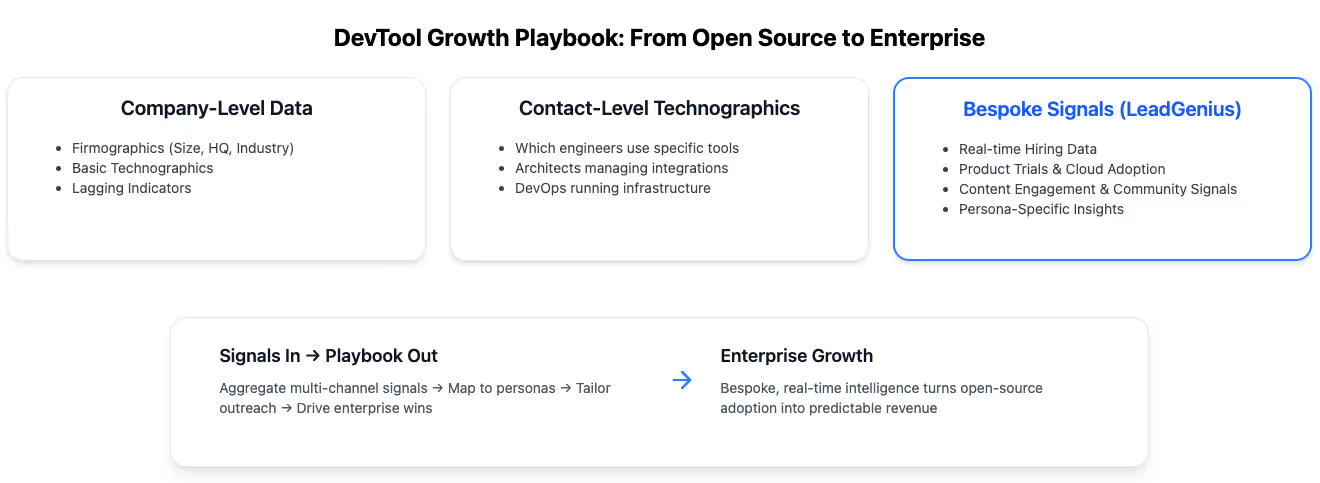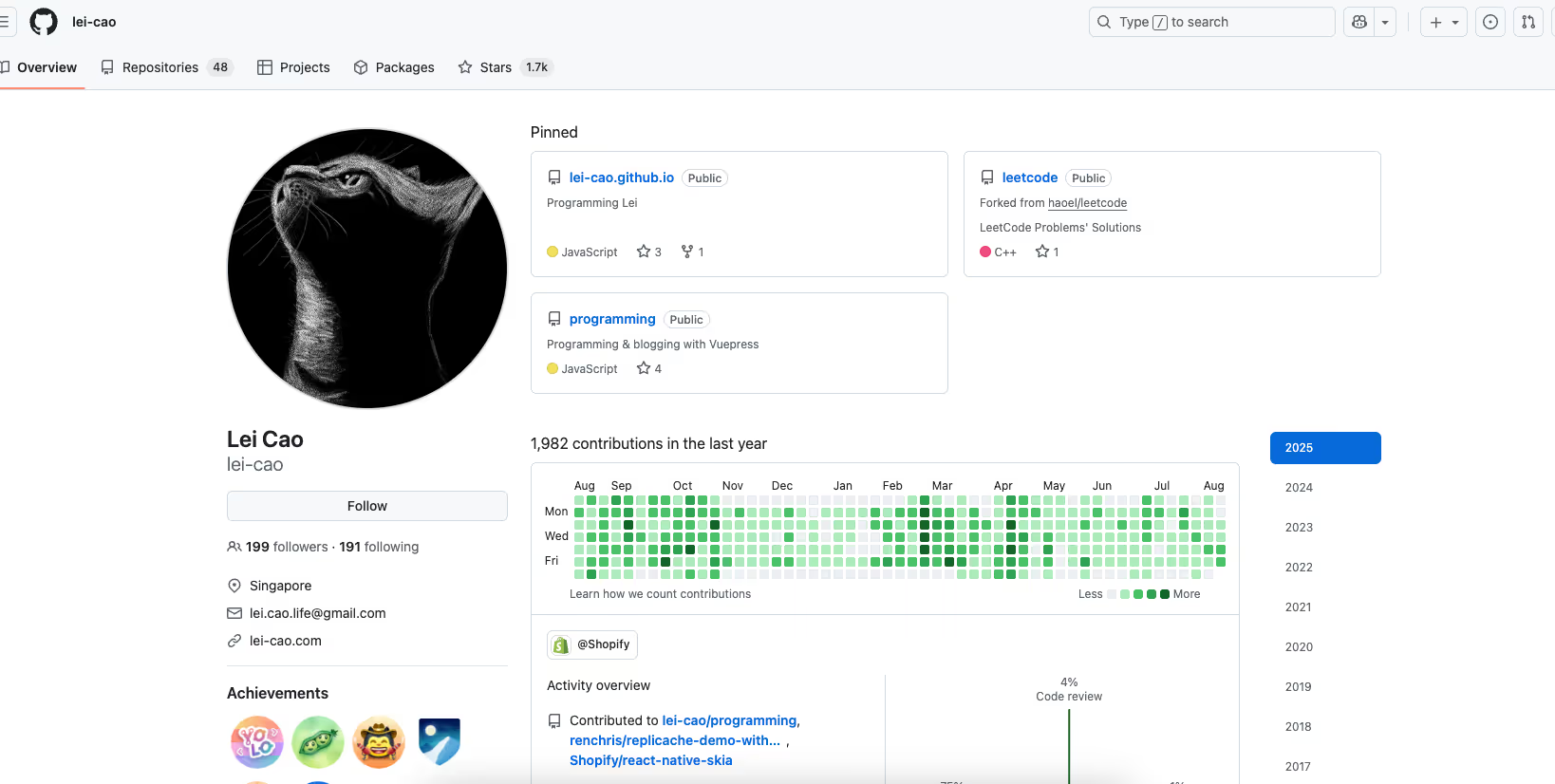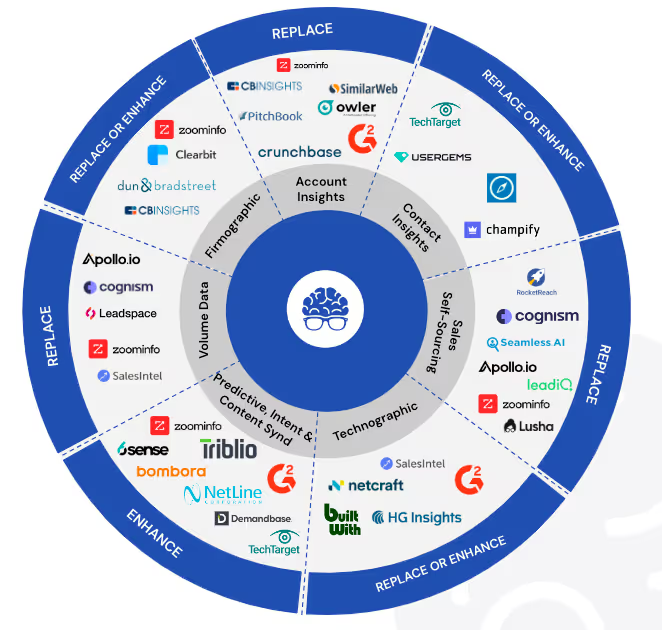Scaling a developer-first business is harder than it looks. Open-source adoption creates momentum, sure, but it doesn’t leave the kind of breadcrumbs sales teams can follow. The messy truth is that if you’re still relying on a static database to tell you who to sell to, you’re not just behind—you’re operating with a map drawn for a world that no longer exists.
The companies that win in this space don’t treat data as a warehouse; they treat it as a living system. They recognize that success isn’t found in a list of names, but in the signals—the hiring patterns, the GitHub repos, the product trial activity—that reveal a company’s actual intent in real time. That’s why the future of DevTool go-to-market isn’t prebuilt. It’s bespoke.
1. Data-Driven Targeting: Finding the Right Accounts
One of the biggest challenges in DevTools is figuring out who is actually using your technology and who’s ready to buy. The most successful teams don’t guess—they aggregate signals across multiple channels to identify intent and prioritize accounts.
Signals that matter include:
- Job postings: Companies hiring for roles related to your technology.
- Social profiles: Developers and engineers listing relevant skills on LinkedIn or GitHub.
- Content engagement: Activity with your blogs, webinars, and tutorials.
- Team size and composition: Number of developers with relevant expertise inside a company.
- Product trials: Engagement with free or self-hosted versions of your product.
- Contact-level technographics: Insight into which specific developers or engineers are actually working with the technologies you complement or compete with.
Contact-level technographics add the missing precision: instead of just knowing a company uses Kubernetes or Kafka, you know which engineers touch it, which architects own it, and which executives fund it. That turns a broad “this company might be a fit” into a laser-focused list of the right people to engage.
2. The Role of Sales: Not Just Developers
Developers may be the entry point, but enterprise deals require multi-level engagement. That’s where SDRs (Sales Development Representatives) come in, bridging the gap between marketing and sales while tailoring outreach to distinct personas.
4 key personas to target with unique messaging:
- Developers: Technical resources, hands-on support, and documentation.
- Architects: Scalability and integration capabilities.
- DevOps: Reliability, automation, and ease of management.
- Executives: Strategic benefits, cost savings, and ROI.
Here, contact-level technographics make SDRs exponentially more effective. Rather than cold-emailing generic “senior engineers,” reps can see who is building in Python, who is deploying Kafka, who manages CI/CD pipelines—and craft outreach that acknowledges their real day-to-day work.
3. Scaling Up: Embracing the Cloud
As products mature, a common inflection point arrives: move to the cloud or get left behind. While on-prem may generate healthy adoption, cloud-native offerings open the door to larger customers, subscription models, and recurring revenue.
The transition is painful—engineering, sales, and marketing all need to adapt—but the payoff is exponential growth, with cloud solutions often outpacing legacy offerings in revenue contribution.
Contact-level technographics play a role here too: they reveal which customers are already cloud-heavy, which ones are in transition, and which teams inside an account are experimenting with new architectures. That intel ensures you time your cloud messaging to align with internal momentum.

4. Lessons and Best Practices for DevTool Companies
The journey from open-source traction to enterprise dominance comes with repeatable lessons:
(1) Define Your ICP Sharply
- Use technographic data (stack data, GitHub repos, cloud usage) to identify audience fit.
- Layer in contact-level technographics to know who in the org is hands-on with those technologies.
- Pivot quickly if outreach shows misalignment.
(2) Invest in Content to Grow the Funnel
- Create educational resources that solve real developer problems.
- Leverage communities for organic distribution.
- Align content with the developer’s journey—from setup to scale—and map it to personas identified through technographics.
(3) Differentiate From Open Source
- Clearly communicate your value proposition beyond free tools.
- Use quantifiable proof points (cost savings, performance metrics).
- Share enterprise case studies that showcase adoption across multiple technical roles.
(4) Leverage Sales Intelligence
- Use intent data plus contact-level technographics for qualification.
- Track both direct product interactions and indirect community engagement.
- Continuously refine lead scoring with who actually uses what at the individual level.
(5) Personalize SDR Outreach
- Pair developer-first content with decision-maker engagement.
- Map outreach to persona-specific pain points—grounded in their real tech stack and responsibilities.
- Ensure every touchpoint delivers tangible value.
Final Takeaway
The firms that win in DevTools don’t just build software—they build ecosystems. They use data to spot opportunity, they speak to every persona in the buying cycle, and they embrace cloud transformation when the time is right.
The biggest unlock? Contact-level technographics. They give sales and marketing the ability to not only know which companies are a fit, but which people inside those companies matter most—and what tech realities shape their day-to-day.
For developer-first companies, this playbook is more than a set of tactics—it’s a roadmap for turning grassroots adoption into enterprise dominance.




